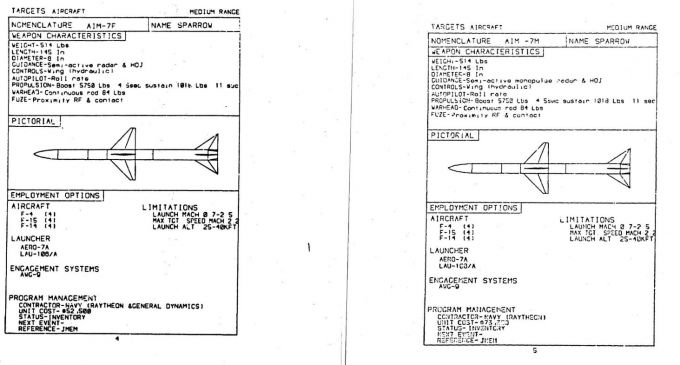FC3
DCS FC3 A/A introductory Guide
Introduction
Weapons
NATO
AIM-7
The Sparrow III is the third major revision of the venerable sparrow design of the early 1950's. It was the frontline BVR A/A missile for the United States Airforce, Marine Core, and Navy until the early to mid 1990's; ultimately being replaced by the AIM-120 series of missiles. The sparrow III, when compared to its predecessors, is a significant improvement in every way, it features a design that was easily upgradable over time. The ultimate version we have in DCS the MH variant features lofting logic and improved CCM performance over previous models.
F
The first Sparrow variant fielded of the new type the F sets the aerodynamics and range for all futures sparrows. Unique to this variant is the ability to home in on either a CW signal or a PD signal. Even though not implemented on the F14 yet, in the future you should be able to choose between the two modes. This in game means all three types of sparrow perform kinematically the same, however the F's chaff resistance is extremely low and can be decoyed with only a few chaff bundles.
M
The upgrade to the F-model, the M build irl received a new, and substantially better, monopulse seeker and a choice between two nose cones. One optimized for radar performance the other for aerodynamic performance. The monopulse seeker gives this missiles an inherent resistance to chaff and ECM. However this means it can only home in on a PD signall. In game the only difference from the F is a substantially improved chaff resistance.
MH
The MH variant is the most modern sparrow currently in DCS. This variant uses parts from the AIM-7P to improve its long range performance with lofting and low altitude performance with newer guidance computers. Additionally, the CCM logic was upgraded substantially. In game this makes the MH the most effective variant due to its lofting and CCM performance making chaff have a very low effectiveness against it.
AIM-120
The AIM-120 is the premier BVR missile of the Western world, it has seen use in the middle east and Balkans. Proving itself to be the most capable operationally used missile of all time. Over the course of its life it has recieved numerous upgrades that have all increased its lethality. The AIM-120 achieves this lethality in no small part due to the fact it is an active missile that has been made exceptionally small yet still has a very poweful motor. Being an active missile it has its own radar to hunt down targets allowing the firing aircraft to retreat the moment it launches. The latest variants of the 120 the D model have even added the ability to fire the missile on datalinked targets and at HOBS targets.
B
The B model AMRAAM was the second iteration of the AIM-120 series with an improved guidance section being the only upgrade over the A model. Externally and internally the two are essentially the same missile. As such the B offers a missile with good range, good maneuverability, and the immense advantage of a fire and forget missile.
C-5
The C-5 is an early 2000's variant of the AMRAAM. It differs from the B in that the fins of the missile were redesigned so they could fit into the weapon bays of the F-22 Raptor. This also has the side effect of offering reduced drag for slight loss in lift. In addition to this over the course of the C's development from C to C-3 to C-4. It has received new warheads, guidance sections, and an every increasingly more powerful and longer burning motor.
AIM-9
The Sidewinder is the longest serving missile series in the world. It has seen massive improvements over the more than 50 years it has been in service. The F16 can currently carry three types the AIM-9L, AIM-9M, and the AIM-9X
L
The '9L' was the first of the "unified" Sidewinder models, as previously the Airforce and Navy had their own unique model, this one was the first to be used by both branches. The L was a major upgrade over all previous sidewinders, heavily based on the AIM-9H the ultimate navy only variant. The L featured a new cooled InSb (Indium Antimonide) FM spin seeker which provides some natural resistance to IR counter measures, a completely new electronics package, increased off boresight capabilities, higher max G, higher launch g (7g's), much longer flight time of 1 minute, New warhead, new and more powerful motor.
M
The '9M' in shape, size, weight, and even appearance is the same missile. But on the inside its electronics got completely overhauled. These new electronics could now filter out flares based on a flares energy rise time. And be reprogrammed to keep it up to date with the latest threats.
In addition these updates almost completely eliminated the effect of background noise on target detection range. In addition to this the 9M got a new smokeless motor that almost completely removed the smoke signature of the missile.


